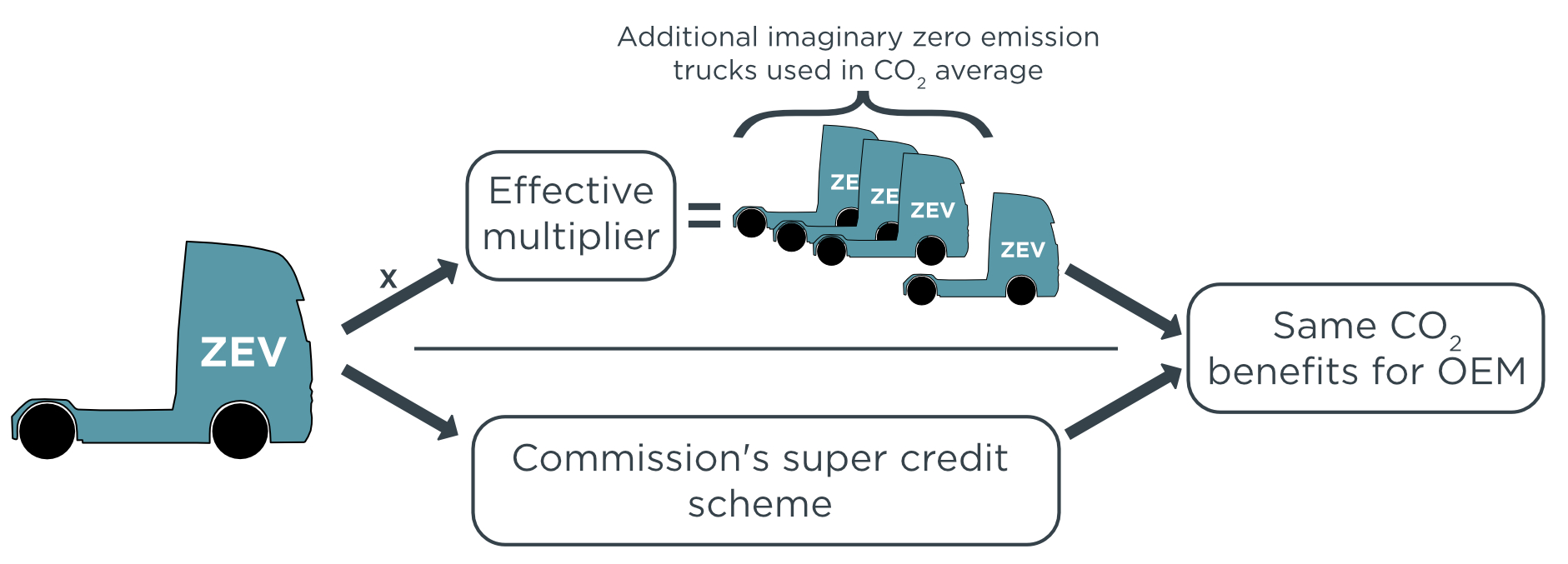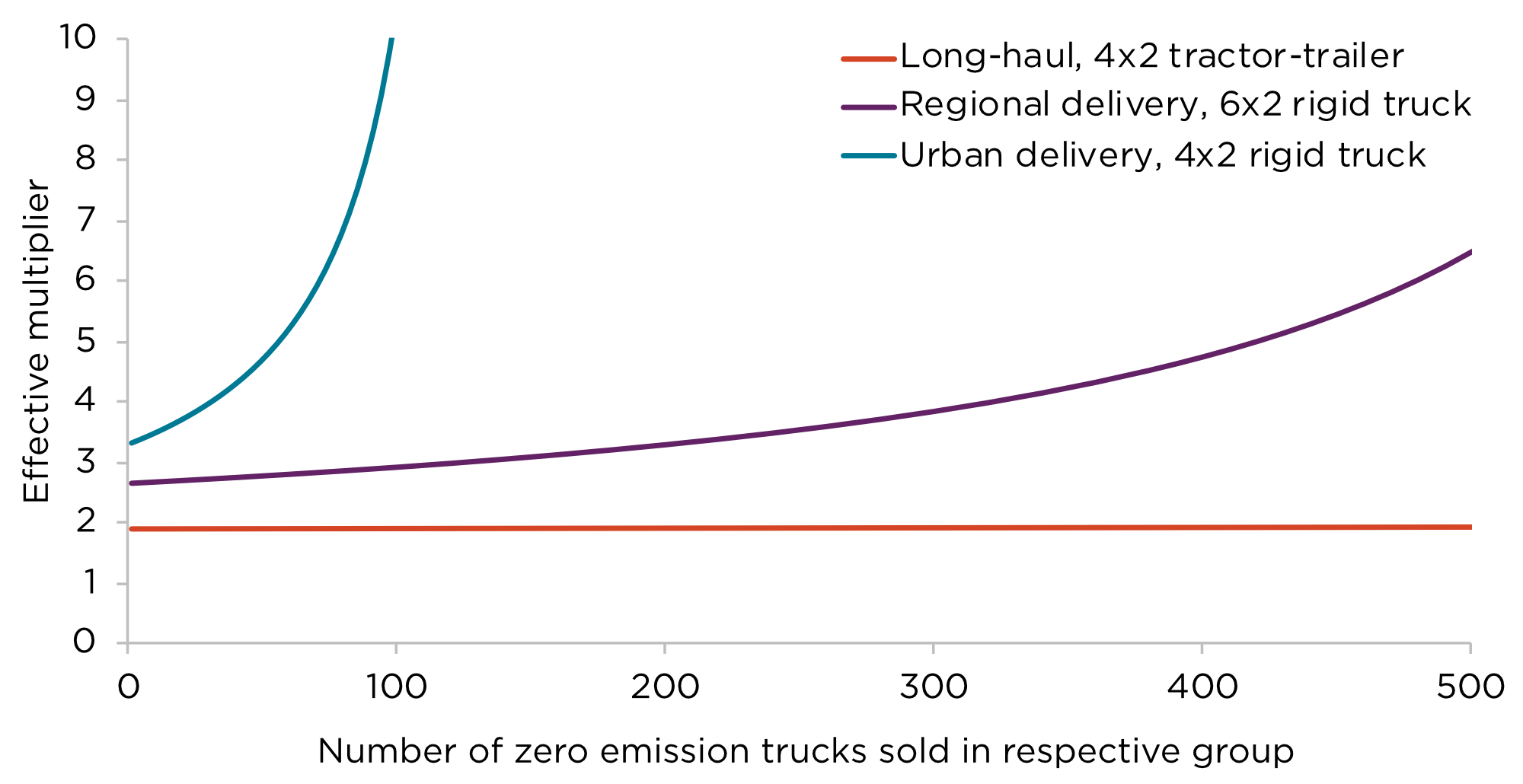Recommendations for the proposed heavy-duty vehicle CO2 standards in the European Union
Blog
Fixing the broken super credits scheme of the proposed HDV CO2 standards
We are entering the final stretch of one of the most important races of the EU to decarbonize transport. If everything goes according to plan, in about four months the EU should become the sixth major market to regulate tailpipe CO2 emissions from trucks. The weeks ahead will have important repercussion on the ability of the EU and its member states to meet their CO2 reduction commitments.
The efforts to regulate CO2 emissions from EU trucks begun in 2009, when the European Commission set out to develop a methodology to certify the CO2 emissions from heavy-duty vehicles. This process culminated in late 2017, when the methodology was finally enshrined into regulation. In the meantime, the Commission started to work on two additional regulations that would build upon the trucks’ CO2 certification procedure. The first, aimed at collecting, monitoring, and reporting the CO2 performance of trucks across manufacturers, was proposed in mid-2017 and adopted in Parliament a year later.
The second regulation, by far the most important to curb the CO2 emissions from trucks, was proposed by the Commission in May of this year. In the proposal, the average CO2 emissions would have to be reduced by 15% in 2025 and 30% in 2030, relative to a 2019 baseline. Zero-emission trucks and buses would be counted multiple times, to incentivize their adoption.
The proposal was quickly taken up in the European Parliament, and an official position was adopted in November which significantly strengthened the proposal. Amendments would mandate a 20% CO2 reduction in 2025 and 35% in 2030, relative to a 2019 baseline. They would also introduce a 5% benchmark, or flexible mandate, for zero-emission trucks by 2025 and 20% by 2030. Buses would be excluded from the zero-emission incentives.
It is now up to the EU Council to make the next move, and an agreement between the different EU member states is likely to be reached in a couple of weeks. The discussions at Council revolve around two main topics: Reduction targets and incentives for zero-emission vehicles.
Truck CO2 reduction targets must be more ambitious if the EU is to meet is climate mitigation goals. At a minimum, the targets should be in line with Parliament’s position and with what the Commission’s impact assessment found to be not only technologically feasible, but also economically beneficial. That is, a 20% reduction in 2025 and 35% in 2030.
The second topic of debate is provisions for zero-emission heavy-duty vehicles. To incentivize the uptake of zero-emission vehicles the Commission chose to employ a mechanism, dubbed super credits, in which zero-emission trucks and buses would count multiple times towards the calculation of a manufacturer’s fleet average emissions. Although super credits help make fleet electrification more cost-effective, they erode the intended environmental benefits of the CO2 standards, and their use amounts to poor environmental policy.
Nonetheless, if super credits are here to stay, we can at least try to make them better and fairer. The credits could be improved by first, getting buses out of the super credit scheme, and second, taking into account the freight activity, or average payload and annual distance traveled, when calculating the super credits.
The electric bus market is market is growing quickly, driven locally by cities aiming to reduce air pollution and by public procurement targets for clean buses in the EU Clean Vehicles Directive. In 2017, over 1,000 battery electric buses were ordered in Europe, more than double the previous year, and the market shows no signs of slowing down.
Buses are not covered yet by the CO2 standards. However, under the Commission’s proposal, an electric bus would offset the emissions of almost two 40-tonne long-haul tractor-trailers; that is, each electric bus sold would reduce the environmental benefits of the standards by over 2 thousand tonnes of CO2. The proposal attempts to limit these negative impacts by capping the contribution of electric buses, and other unregulated truck types, to 1.5% out of the 15% reduction target for 2025.
Using sales data of the past five years, I estimate that, on average, each manufacturer would need to sell a modest 240 electric buses a year to reach the 1.5% cap proposed by the Commission. Some manufacturers, like Volvo, already sell close to that amount of electric buses. Others, like DAF, would not be able to reap the benefits, since they don’t have a bus division. Awarding super credits for electric buses would clearly tilt the balance in favor of certain manufacturers and would reduce the benefits of the standards by tens of millions of tonnes of CO2.
Another way to improve the super credit system is to account for freight activity when calculating credits. The calculation of the fleet average CO2 emissions of a manufacturer uses a set of weighting factors to account for the differences in freight activity between the truck types. For example, the CO2 emissions of a long-haul tractor-trailer are weighted 10 times higher than those of an urban rigid truck. It is a clever approach that allows a single CO2 value for each manufacturer, while considering the differences within the fleet. Unfortunately, the Commission decided not to use this approach when calculating the super credits.
To illustrate the impact of failing to account for freight activity, one must delve into the details of how the fleet average CO2 emissions are calculated. Trucks are grouped based on type (rigid or tractor truck), axle configuration (4×2 or 6×2), and typical usage (urban delivery, regional delivery, or long-haul). For each group, the CO2 emissions are calculated by the simple averaging of CO2 emissions of the trucks in the group, including the zero-emission vehicles. Next, the different groups are combined into a sales weighted average using the freight activity weighting factors described above. In the last step, the fleet average CO2 emissions are multiplied by a factor that captures the super credits given to zero-emission trucks. So, if out of the 50,000 trucks that a manufacturer sells a year, 500 are electric, then the super credits factor would be 50,000 divided by 50,500, equal to 0.99.
So, zero-emission trucks are counted once in the group averaging, and then again in the super credits factor. However, in the second accounting, it does not matter if the zero-emissions truck was small urban rigid truck with low freight activity, or large long-haul tractor-trailer with high freight activity. They are all counted the same. As a result, although the Commission chose a nominal value of 2 for super credit multiplier, the “effective multiplier” for smaller zero-emission trucks is significantly higher than for larger trucks. By effective multiplier I mean the number of times that zero emission vehicles would need to be accounted in their respective group average, to have the same impact in the fleet average CO2 emissions as in the Commission’s super credits proposal.

To illustrate, I calculated the effective multiplier for three very different truck groups as a function of the number of zero emission trucks sold in the respective group. What I found is quite striking. Take a look at the chart below.

As a first observation, the effective multipliers are not constant, they are not even linear. The more zero emission trucks there are in a group, the more they count. The second observation is that while for the long-haul tractor-trailer group the effective multiplier stays fairly constant at around 2, for the urban rigid trucks the effective multiplier starts at 3.3 for a single zero emission truck, and quickly climbs to over 10 when more than 100 zero emission trucks are sold. At around 130 zero-emission trucks, the emissions multiplier goes to infinity (not shown in the plot, as infinity is always hard to plot). That is, even if the average emissions of the whole group were zero, you would still not get the same benefits that the Commission’s approach would give you. Pretty sweet deal, don’t you think?
In summary, the Commission’s super credit approach puts the incentives in the wrong place. Trucks with higher freight activity are harder to electrify. Yet, in the current proposal, smaller, easier to electrify trucks would receive significantly higher incentives. One way to correct this situation, is to ensure that all truck groups receive the same effective multiplier, and that it stays constant regardless of the amount. The fix (described in more detail here) involves letting the freight activity weights do their job, and instead of having a one-size-fits-all super credits factor, to have individual factors for each vehicle group.
There is still time for the Council to get the super credits right, if that’s the path they choose. If the negotiations in early 2019 are successful, we can expect Parliament to vote on this file in the March plenary sittings, and officially bring Europe up to speed with the rest of the major markets. The finish line is in sight. But please, don’t forget to fix the super credits!
PS: I keep hearing the argument, that since the super credits in the current HDV GHG standards in the United States are higher, then the EU should follow suit. The US super credits were proposed by California, using old data that does not really apply to trucks. Check it out for yourselves.
